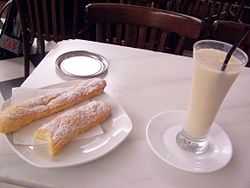Horchata


Horchata (/ɔrˈtʃɑːtə/; Spanish: [orˈtʃata]), or Orxata (Catalan pronunciation: [oɾˈʃata]), is the name of several kinds of traditional beverages, made of ground almonds, sesame seeds, rice, barley, or tigernuts (chufas).
Etymology
The name derives from Catalan orxata, probably from ordiata, made from ordi (barley) (Latin *hordeata < hordeum). The Italian orzata, the French and English 'orgeat' and the Surinamese Dutch orgeade have the same origin, though the beverages themselves have diverged, and are generally no longer made from barley.[1]
Various false etymologies exist – one legend links the origins of the name to James I of Aragon, who after being given the drink for the first time by a local in Alboraya, was said to have exclaimed in Valencian "Açò és or, chata!" ("That's gold, darling!")[2][3]
Spain
In Spain, it usually refers to orchata de chufa (horchata de chufa), made from tigernuts, water, and sugar.
Originally from Valencia, the idea of making horchata from yellow nutsedge comes from the period of Muslim presence in Valencia (from the eighth to thirteenth centuries).
It has a regulating council[4] to ensure the quality of the product and the villages where it can come from, with the Denomination of Origin. The village of Alboraia is well known for the quality of its horchata.
It is served ice cold as a natural refreshment in the summer, often served with fartons. Tigernut horchata is also used instead of milk by the lactose intolerant.
Latin America
Horchata varies in taste across Latin America.
While in some countries the drink is usually tan and "milky", some recipes call for milk, and others do not. Other ingredients often include sugar, cinnamon, and vanilla. Though horchata was once typically homemade, it is now available in both ready-to-drink (shelf-stable or refrigerated) and powdered form in grocery stores. Horchata, together with tamarindo and jamaica, are the three typical drink flavors of Mexican aguas frescas.
- In Mexico and Guatemala, horchata is made of rice, sometimes with vanilla and always with cinnamon.
- The horchata found in the south of Honduras and in El Salvador is primarily made from morro seeds, not rice. Other common ingredients include ground cocoa, cinnamon, sesame seeds, nutmeg, tigernuts and vanilla. Other nuts that may also be used include peanuts, almonds and cashews. Because of these ingredients, the horchata is usually strained before serving.
- In Nicaragua and Honduras, horchata refers to the drink known as semilla de jicaro, made from the jicaro seeds ground with rice and spices. The drink is made with cold milk and sugar, and is very popular nationally. Recently, Nicaragua has begun exporting this product, primarily to the United States.
- In Puerto Rico, horchata is called horchata de ajonjolí and made with ground sesame seeds. Water is boiled with sugar, vanilla, and cinnamon sticks. When done the water is poured over the ground sesame seeds and left over night. The water is then squeezed through a cheese cloth. Some recipes call for added ground rice, ground almonds, evaporated milk, coconut milk, allspice and rum. Horchata with barley and lime zest is also popular, but mainly in homes.
- In Venezuela, horchata is made with sesame seeds, water and sugar in the western area, Zulia. There is also chicha, made with rice flour, milk and sugar. The alcoholic variant is called chicha andina which is made with fermented corn flour.
- In Ecuador, horchata is a clear red infusion of 18 herbs, and is most famous in the province of Loja.
United States
- In the U.S., rice-based or morro horchata is served in many Latin restaurants, and the horchata de chufas (tigernut) is virtually unknown. Rice-based horchata is also sometimes available in U.S. grocery and convenience stores.
- Some smoothie shops, cafés, and McDonald's in the U.S. have been experimenting with horchata frappes.[5]
References
- Notes
- ↑ Lobscouse & Spotted Dog: Which It's a Gastronomic Companion to the Aubrey/Maturin Novels : Grossman, Anne Chotzinoff; Thomas, Lisa Grossman ISBN 0-393-04559-5
- ↑ Valencia & the Costa Blanca, Miles Roddis, Lonely Planet, 2002, ISBN 1-74059-032-5 Google Books
- ↑ MTV Spain, Fernando Gayesky, Elizabeth Gorman, Kristin Luna, Andre Legaspi, Frommer's, 2007, ISBN 0-7645-8772-2 Google Books
- ↑ "Consejo Regulador de la D.O. Chufa de Valencia. Horchata de Chufa de Valencia - Portada". Chufadevalencia.org. 2002-12-31. Retrieved 2014-07-15.
- ↑ "McDonald's Testing Horchata Frappes in Southern California". Foodbeast. 2014-05-12. Retrieved 2014-07-15.
External links
- The Regulating Council of Denomination of Origin "Chufa de Valencia": Quality council regulating tigernut horchata in Valencia
- Article about Horxata, Ltd.: Valencian Horchata in New York City
| |||||||||||||||||||||||||||||||||||||
| ||||||||||||||||||
.svg.png)